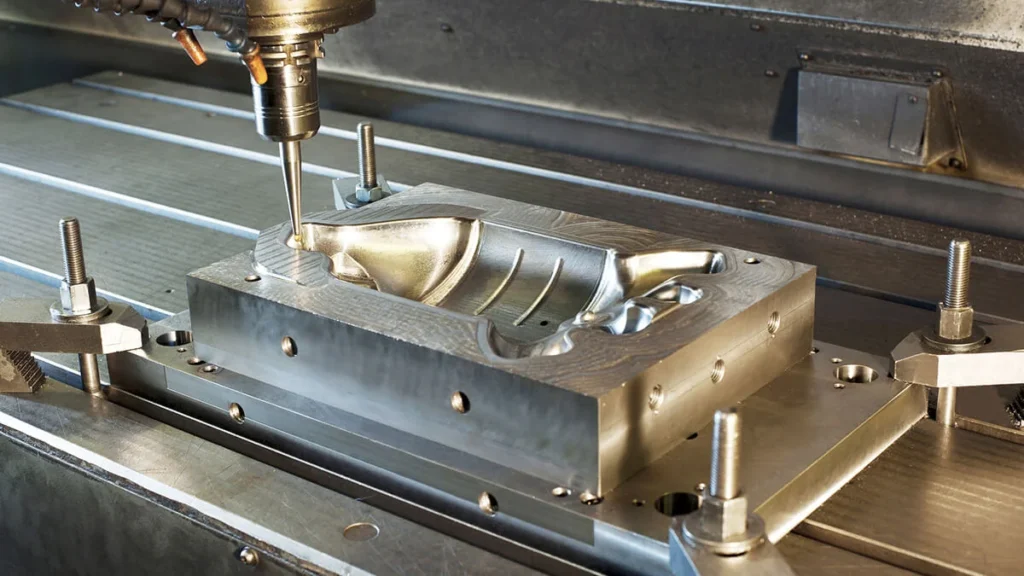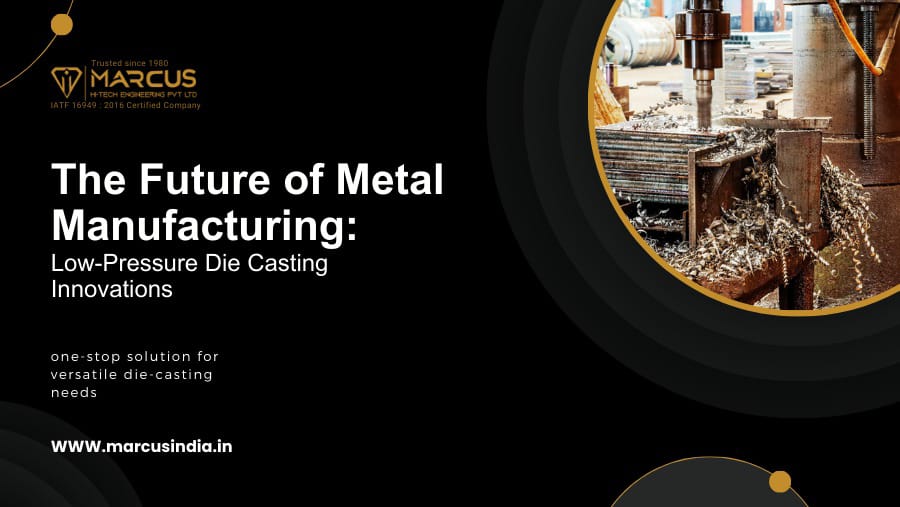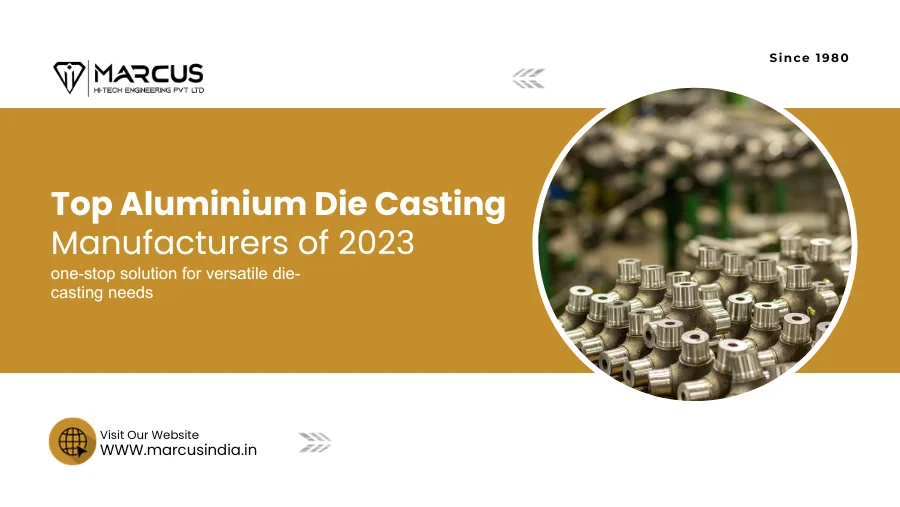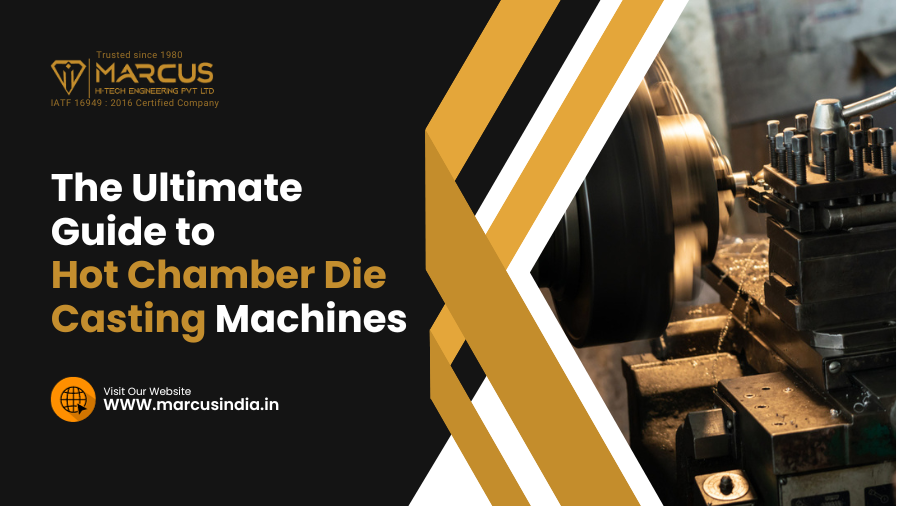Industries such as automotive, aerospace, and electronics require high-quality metal components that meet strict standards for accuracy, surface finish, and corrosion resistance. To achieve this level of precision, aluminum die casting is the preferred method.
At its core, aluminum die casting is an ingenious process that engineers high-quality metal components with unparalleled accuracy. It accomplishes this feat by coercing molten metals into meticulously crafted molds under immense pressure. This manufacturing marvel has become a cornerstone of various industries, underpinning the production of components that redefine excellence.
This blog unveils the aluminum die casting process and its benefits across industries. Let’s get started!
Aluminum Die Casting Process

The Aluminum die casting process involves various steps. Here is the step-by-step process-
Die Design and Manufacturing
- The aluminum die casting process begins with creating a two-part steel mold called a die or a tool. These dies are created to match the desired shape and specifications of the final aluminum part.
- The die has two halves: the stationary half (cover die) and the movable half (ejector die). The mold includes cavities and channels to facilitate molten aluminum’s flow.
Melting Aluminum
- Aluminum alloy bullets melt in a furnace, where the temperature and composition are monitored and controlled.
- The choice of aluminum alloy depends on the desired properties of the final part, such as strength, corrosion resistance, and thermal conductivity.
Injection
- The molten aluminum is injected into the die cavity at high pressure using a hydraulic press or an electrically operated machine.
- The high pressure ensures that the aluminum flows entirely throughout the mold, filling all the intricate details of the part.
Cooling
- After injection, the molten aluminum rapidly cools and solidifies within the die cavity.
- Proper cooling is crucial to prevent defects like porosity and to ensure the part has the desired mechanical properties.
Ejection
- Once the aluminum has solidified, the two halves of the die are separated. The movable half (ejector die) is used to push the finished part out of the mold.
- The ejection system includes pins or ejector plates to assist in removing the part from the die.
Trimming and Finishing
- After ejection, the part may have excess material, such as flash or gate remnants, trimmed or removed.
- Additional finishing processes, such as machining, drilling, or surface treatments, are performed to meet the desired specifications and appearance.
The finished parts undergo a rigorous inspection to meet quality standards and specifications.
Aluminum Die Casting Materials
Several materials are essential for manufacturing high-quality metal components in the aluminum die casting.
Aluminum Alloys
Aluminum alloys are the primary components of the aluminum die casting process. Aluminum alloys offer a combination of lightweight properties, corrosion resistance, and good mechanical properties. Some of the major alloys are; aluminum silicon alloys, aluminum copper alloys, aluminum zinc alloys, and aluminum magnesium alloys.
Molds
The molds or die used in the aluminum die casting are made of high-quality steel such as tool or H13 steel. The dies are created to withstand high temperatures and achieve high dimensional accuracy.
Release Agents
To ensure the smooth release of the solidified metal from the die, release agents are applied to the die surfaces. These release agents prevent the metal from sticking and help in easy ejection.
Lubricants
Lubricants are applied to the machine’s moving parts to prevent wear and tear.
Cooling Fluids
Cooling fluids help to regulate the temperature in the Aluminum Die Casting Process, which is crucial to facilitate the solidification rate of aluminum.
Trimming and Finishing Materials
The extra material that remains on the metal components at the end, known as flash, is removed from trimming material, cutting tools, or abrasives.
Surface Treatments
If surface finishing or smoothening is required at the end, tools like paints, powder coatings, anodizing solutions, or other surface treatment chemicals are used.
Aluminum Alloys Used in Aluminum Die Casting
There are plenty of alloys used in the aluminum die casting process. Below are some of the most important ones-
A380
A380 is a famous aluminum alloy known for its strength, flexibility, and castability. It has excellent fluidity and thermal resistance, making it easy to shape into complex parts using die casting. It offers decent strength and is frequently used in automotive, electronics, consumer goods, and industrial applications where lightweight and durable components are needed.
A383 ( ADC12)
A383 is a cost-effective alloy with high silicon and low copper levels. Its excellent castability and machinability make it ideal for intricate mold designs and precise post-casting processes. It’s often used for automotive and electrical components due to its strength and corrosion resistance.
A360
A360 is a well-known die cast aluminum alloy used in the automotive industry for engine parts, structural elements, and transmission cases. Its properties include fluidity, corrosion resistance, and high-temperature stability, making it ideal for die casting applications. The alloy has exceptional fluidity when molten, making it suitable for intricate molds and complex shapes. It also has good pressure tightness properties, making it ideal for hydraulic components.
Advantages of Aluminum Die Casting
Lightweight
Aluminum is a lightweight material, precious in industries where weight reduction is crucial, such as automotive, aerospace, and consumer electronics. Lightweight components can improve fuel efficiency in vehicles, reduce transportation costs, and enhance the overall efficiency of products.
Flexibility
Aluminum die casting allows for the production of intricate and complex parts with high precision, making it flexible for creating components with fine details, thin walls, and intricate shapes.
Rapid Production
The process offers a fast production cycle. The process allows for high-volume production in a limited time. This flexibility in production speed is advantageous for meeting changing market demands and tight project timelines.
Resistance to Corrosion
Aluminum’s corrosion resistance is created by an inert oxide film forming on a metal surface that provides a protective layer, preventing the aluminum surface from exposure to its surroundings.
Aluminum die casting uses corrosion-resistant aluminum alloys. These alloys include additives like silicon, copper, and magnesium, which enhance the material’s natural resistance to corrosion.
High Precision and Surface Finish
The die casting process offers high dimensional accuracy, ensuring that the components consistently meet exact specifications. It also provides a smooth and high surface finish, reducing the need for additional surface treatments.
Tight Tolerance
Tight tolerances mean that the dimensions of Die-Cast aluminum parts are closely controlled and highly accurate. This is critical for ensuring that pieces fit together perfectly in assemblies, reducing the need for additional adjustments or modifications.
In industries like automotive and aerospace, where weight reduction is crucial, tight tolerances ensure that components are manufactured precisely to meet design specifications. This optimization can lead to improved fuel efficiency, performance, and safety.
Applications of Aluminum Die Casting
Aluminum die casting is used in various industries due to its ability to produce products with precise dimensions and lightweight parts.
Some of the major industries in which aluminum die casting is applicable are:
Automotive:
- Engine components for improved efficiency.
- Brake calipers for safety.
- Transmission housings for precision.
Aerospace:
- Aircraft parts for strength.
- Avionics housings for electronics.
- Aircraft interiors for customization.
Electronics:
- Housings for shielding.
- Heat sinks for cooling.
- Connectors for reliability.
Industrial Machinery:
- Pump components for durability.
- Valve bodies for precision.
- Machine frames for stability.
Telecommunications:
- Antenna housings for signal integrity.
- Satellite components for communication.
- Networking equipment for reliability.
Lighting:
- LED fixture housings for durability.
- Streetlight components for longevity.
- Automotive lighting for precision.
Aluminum Die Casting Design Guide
Material Selection
Choose the suitable aluminum alloy for your product based on desired properties like corrosion resistance, strength, and thermal conductivity. Commonly used die casting alloys include A380, A383, and ADC12.
Parting Lines
The parting line of a die-cast component is the interface where the two halves of the die come together. Choosing the location of the parting die is crucial as it affects other design aspects.
Draft
A draft is a slope on a mold that makes it easier to remove the cast. It should be included on all surfaces parallel to the die’s movement. Without it, removing the cast can be very difficult and cause damage.
Wall Thickness
Wall thickness must be carefully evaluated and uniform for solidification and to reduce the risk of defects. A general guideline is to keep walls between 2 to 5 mm (0.08 to 0.20 inches) thick.
Ribs
Ribs can be added between walls to strengthen them and improve the flow of molten metal in a die.
Undercuts
Avoiding undercuts in die casting is crucial to prevent issues with separating the die and ejecting the product. These can lead to costly tooling modifications, so minimizing or eliminating them is best.
Boss
Mounting points and bosses are essential in production, but incorrect design can cause manufacturing problems and higher costs. Proper design includes drafts and large fillets for optimal metal flow.
Assembly Considerations
Some standard assembly options for aluminum die cast parts include threading, fastening, welding, cored holes, injected metal assembly, etc.
Also Check: Techniques to Optimize Heat Treatment in Aluminium Die Casting
Over To You
In conclusion, the aluminum die casting process is a versatile and essential manufacturing method applicable in various industries, from automotive and aerospace to renewable energy. Its ability to produce complex, high-quality parts with precision and efficiency makes it a preferred choice for multiple components.
By teaming up with a suitable aluminum die casting supplier, manufacturers can obtain high-quality components that are precise and reliable for their projects. One dependable partner is Marcus Hi-Tech Engineering, renowned for their innovative aluminum die casting techniques and unparalleled outcomes.
FAQs
Aluminum die casting is a manufacturing process that involves injecting molten aluminum into a mold cavity, allowing it to solidify, and then removing the finished product from the mold. It’s a highly efficient method for producing complex, precise, and lightweight metal components.
Aluminum die casting offers several advantages, including excellent dimensional accuracy, high-strength parts, good thermal conductivity, and the ability to produce intricate shapes and thin walls. It’s also cost-effective for large-scale production.
Aluminum die casting is widely used in various industries, including automotive, aerospace, electronics, and consumer goods. It’s preferred for applications that require lightweight and durable parts.
Compared to other methods like machining or forging, die casting typically requires less post-processing, resulting in cost savings and faster production times. It also offers better material utilization.









